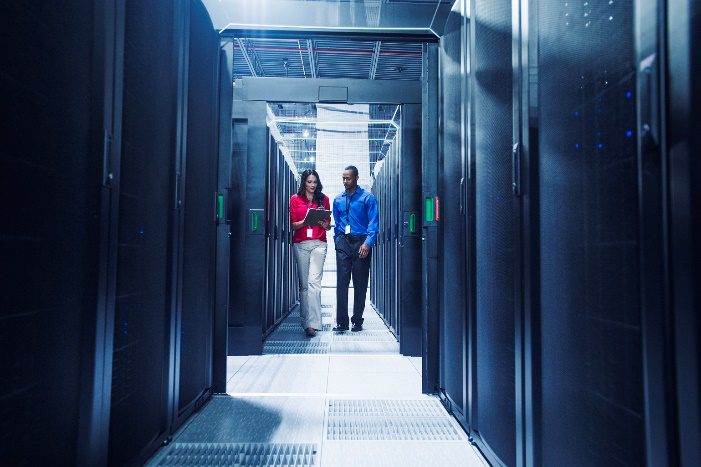The Struggle Tech Companies Face Managing Energy and Sustainability Data
The deployment and adoption of technologies and services for energy and sustainability management is accelerating. A continued reduction in the cost of sensing technology and cloud-based processing have made it easier than ever for organizations to collect, store and analyze large amounts of data. Corporations can now capture and monitor granular energy and resource consumption in real time. Yet, many — including technology, cloud/colo, and data (TCD) companies — still struggle to turn this data into actionable insights.
The Real Data Challenge

Data is readily available. What companies struggle with is ensuring data quality and using information to foster sharing and collaboration.
In many cases, these granular energy data streams are new to building operators and managers and provide more analysis and optimization opportunities than ever before. But the collection and analysis of energy and sustainability data can also be daunting, especially as the amount of available data continues to increase and the need to ensure data quality becomes acute.
One barrier to collaboration is the data source. A recent survey of more than 300 corporate energy and sustainability professionals, conducted by Schneider Electric and Greenbiz, revealed that 74% of TCD companies are still relying on spreadsheets to manage their energy and sustainability data, while only 26% report using IoT-enabled devices.
Data Visibility and Fluency are Crucial
The ability to easily share data has significant benefits. The same research shows that 100% of the TCD respondents who reported that “departments see all data” agree or strongly agree that they can make business cases to secure funding for energy and sustainability projects.
Yet, there are a variety of barriers that make data sharing a challenge. In some cases, the quality of the data is suspect, or it is difficult to manipulate, which may make it less valuable. For example, 45% of TCD companies note that the data they collect is incomplete and 50% report having insufficient tools to use the data. More importantly, 41% of respondents note that they do not have the right internal expertise to act on data — a significant talent barrier in a rapidly digitizing world and digital skills market.
As data becomes more trustworthy, it also becomes more important to share. Respondents that said that they share all data have higher adoption rates of IoT devices and Energy Management Systems (EMS). They are also less dependent on spreadsheets.
Technology is Only One Key to Success

The increased adoption of software and other technology to collect, manage and analyze energy and sustainability data makes it easier to share data across organizations and with third parties like reporting agencies.
However, even with these technology-enabled solutions in place, TCD companies still need to develop internal processes to share data, analyze it and implement it across their organization. The research suggests this is trending. For example, companies that have deployed an EMS report that they are more successful in their efforts to develop a business case for sustainability projects and initiatives.
Take Action: Learn from Leaders
Here’s how leading companies in different industries have overcome the data collection and sharing challenge.
- Use of real-time metering with data shared across the organization: A leader in commercial real estate uses EcoStruxure
 Resource Advisor to create dashboards containing real-time metering data from across the property portfolio. Within minutes, the vice president of engineering can get a complete picture of energy demand. This allows his team to adjust quickly, instead of waiting 30-45 days until the utility bill arrives. Furthermore, he can share this corporate-level data with third-party partners like ENERGY STAR, LEED and GRESB, and use the data as proof with internal stakeholders to validate the program’s success.
Resource Advisor to create dashboards containing real-time metering data from across the property portfolio. Within minutes, the vice president of engineering can get a complete picture of energy demand. This allows his team to adjust quickly, instead of waiting 30-45 days until the utility bill arrives. Furthermore, he can share this corporate-level data with third-party partners like ENERGY STAR, LEED and GRESB, and use the data as proof with internal stakeholders to validate the program’s success. - Deployment of submetering systems and locally-configurable interfaces: A global aerospace organization has implemented submeters across its top 40 sites during the last 3 years, giving the company more granular energy consumption data. Each local team was trained so they could access and monitor the data themselves without corporate oversight. In another example, an agricultural company is leading a change management operation that will enable teams on the ground to take ownership of their day-to-day energy performance and increase proficiency.
- Investment in data analysis expertise: A leading global retail company admits to being handicapped in the past by not having enough resources to analyze its data. The current goal is to hire analysts to drive better decision-making based upon the data that is available.
- Alignment of corporate and sustainability goals: A banking institution ensures that all its internal departments have visibility into the overall business strategy and long-term organizational vision. Sharing of data becomes core to this exercise, which helps the sustainability team secure approval and funding for key initiatives.
Want to learn more about how your data management and sharing processes stack up against others in the TCD industry? Take our assessment to find out.
The post The Struggle Tech Companies Face Managing Energy and Sustainability Data appeared first on Schneider Electric Blog.